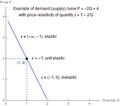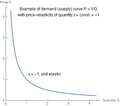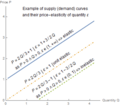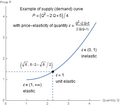Elasticity (economics) facts for kids
In economics, elasticity is a way to measure how much one thing changes when another thing changes. Think of it like a rubber band: how much does it stretch when you pull it? In economics, we often look at how much supply (how much is available) or demand (how much people want) changes when things like price or income change.
Contents
What is Price Elasticity?
One common type of elasticity is price elasticity. This tells us how much the demand for a product changes when its price changes.
Price-Elastic Demand
Imagine something like DVDs. If the price of DVDs goes up, people will probably buy fewer of them. This is called price-elastic demand. It means that the demand for DVDs is sensitive to their price. If the price changes a little, the demand changes a lot.
Price-Inelastic Demand
But what about something like salt? Even if the price of salt goes up, people still need it for cooking and their health. So, they will likely buy the same amount. This is called price-inelastic demand. It means the demand for salt doesn't change much, even if its price changes.
How is Elasticity Measured?
Economists measure elasticity using percentages. For example, if the price of a product goes up by 2% and people buy 1% less of it, the price elasticity of demand would be -0.5. This number helps us understand how sensitive buyers are to price changes.
Related pages
| Topics in microeconomics |
|---|
| Scarcity • Opportunity cost • Supply and demand • Elasticity • Economic surplus • Economic shortage • Aggregation of individual demand to total, or market, demand • Consumer theory • Production, costs, and pricing • Market forms • Welfare economics • Market failure |
Images for kids
See also
 In Spanish: Elasticidad (economía) para niños
In Spanish: Elasticidad (economía) para niños









